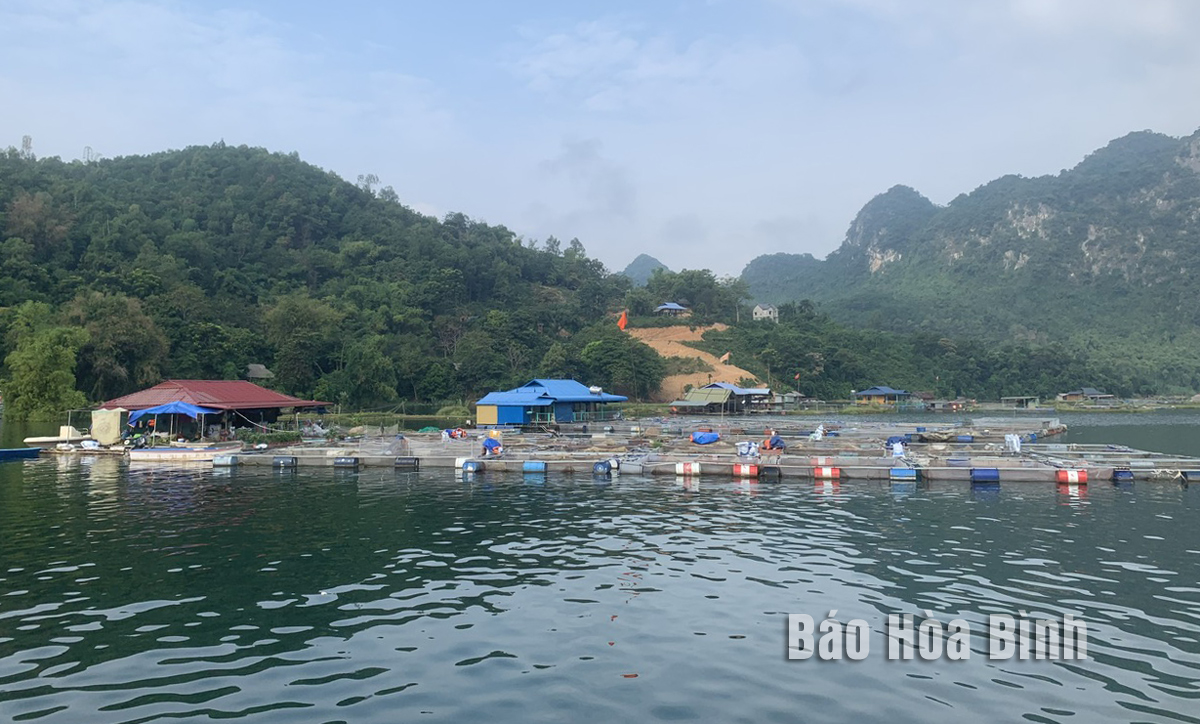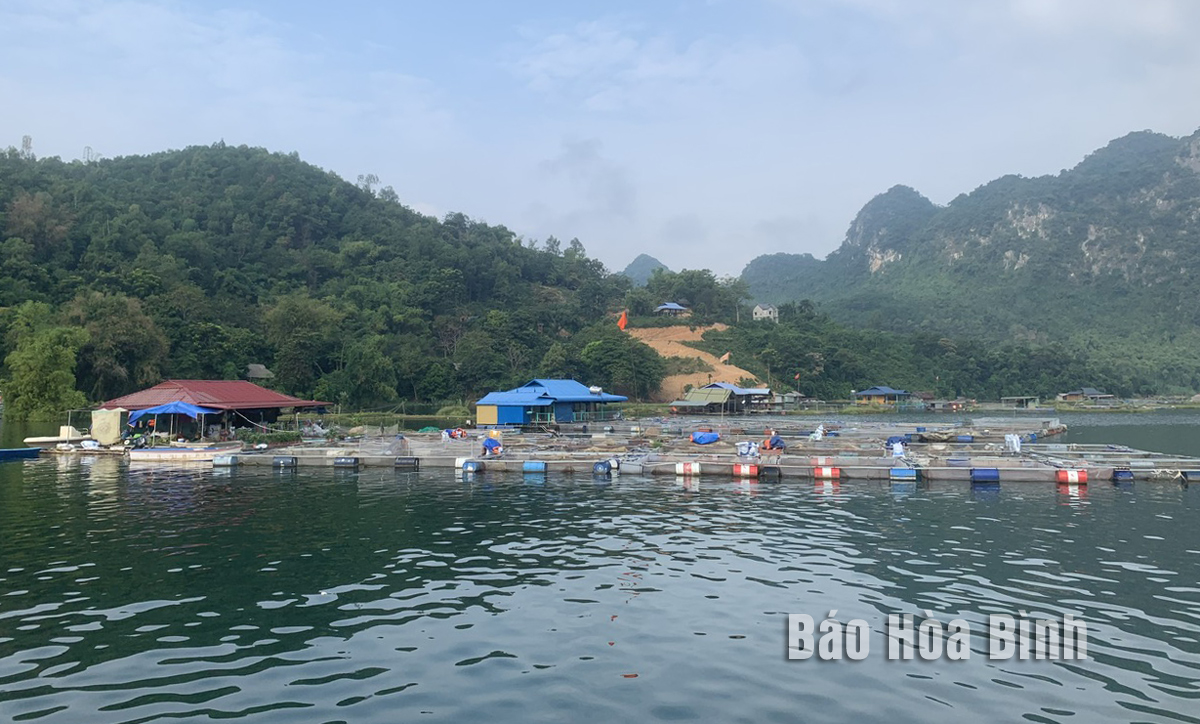
Agricultural production based on value chains is recognised as a sustainable approach that improves production efficiency and raises farmers' and businesses' incomes. Many enterprises and agricultural cooperatives in Hoa Binh have applied high-tech methods to production, linking their efforts to building value chains for their products.
Currently, many enterprises and
cooperatives in Hoa Binh have engaged in cage fish farming on the Da River have
adopted value chain-based production, contributing to high economic efficiency
and creating jobs for many local workers.
Synchronising
mechanisms, policies for agricultural production in value chains
A value chain refers to a sequence of activities
where each step adds value to the product. In agriculture, this includes input
activities, production, processing, and trade. The agricultural production
chain involves coordination among fertiliser suppliers, seed providers,
livestock breeders, farmers, cooperatives, processing companies, and
distribution channels like markets, supermarkets, and export outlets.
To promote agricultural production through value
chains, increase farmer income, and ensure participants’ rights and
responsibilities, the Government issued Decree No. 98/2018/ND-CP on July 5,
2018, to encourage cooperation and linkage in agricultural production and
consumption. The provincial People's Committee responded by issuing Decision
No. 2793/QD-UBND on December 20, 2018, to approve priority agricultural
products for support and consumption. Furthermore, the Provincial People's
Council passed Resolution No. 226/2019/NQ-HDND on December 11, 2019, focusing
on support for production linkages and consumption of agricultural products
during 2020-2025.
With the issuance of these policies, the
province has built an effective mechanism to implement agricultural production
chains. The provincial People's Committee has integrated production linkages
into socio-economic development plans. Moreover, the province has established
support activities and funding standards for participants in the value chains,
in line with Decree No. 98/2018/ND-CP.
Ha Ngoc Tuan, Chairman of the Hoa Binh
Cooperatives’ Alliance, emphasised that cooperatives play a vital role in
agricultural value chains. With support from central and local authorities,
cooperatives are encouraged to shift to value chain-based production. The
alliance has organised conferences to foster production linkages and product
consumption for agricultural products from cooperative members.
By the end of 2023, the province had over 100
linked production chains providing safe food, covering vegetables, aquatic
products, livestock, and processed products. Four of these chains received
budget support. In 2024, the provincial People's Committee allocated over 166
billion VND (6.52 million USD) for building value chains and approved 12
related projects. These projects are located across districts like Kim Boi, Lac
Son, Tan Lac, Cao Phong, and Da Bac, covering products such as peppers,
vegetables, sweet corn, potatoes, local chickens, sugarcane, and Cao Phong oranges.
Building
sustainable value chains in agriculture
Value chains play a significant role in
agriculture, especially as economies become more integrated globally. Haa
Binh’s agricultural products are not only for domestic consumption but
are also aimed at export. Some of the province’s key agricultural products,
such as Dien Ngoc Luong grapefruit, red-fleshed grapefruit from Tan Lac, and
Cao Phong oranges, are already exported. The province’s agricultural sector
reports that many farming areas in these value chains have received
certifications like VietGAP, GlobalGAP, and organic product certifications,
enhancing access to larger markets. Additionally, cooperatives and businesses
sign contracts with supermarkets and distributors, ensuring stable product sales.
Despite the successes, challenges remain,
particularly in linking value chain stages and ensuring sustainable
consumption. Vu Thi Le Thuy, Director of 3TFarm Cooperative in Cao Phong,
pointed out that the collection, processing, and consumption stages lack
sustainability, with many intermediaries involved. For example, Cao Phong
orange farmers mostly sell to middlemen. Even though 3TFarm is a well-known
cooperative, it often has to seek sales channels independently, she said.
To address these issues, the Hoa Binh
Cooperative Alliance has organised forums to promote production linkages and
consumption. Tuan suggested that improving human resources in cooperatives
through training is key, along with supporting businesses to collaborate with
cooperatives. Strengthening quality standards and product traceability is
crucial for enhancing competitiveness and ensuring food safety.
Developing agricultural value chains has not
only boosted market competitiveness but also supported sustainable economic
growth. Vuong Dac Hung, Deputy Director of the provincial Department of
Agriculture and Rural Development, emphasised the importance of planning and
resource allocation to improve infrastructure, attract investment, and
integrate scientific advances into production. Hung also pointed to the need
for strengthened State management and contract enforcement, and close
supervision of agricultural material market as well as the quality of farm
produce in the process.
According to data from the Hoa Binh Provincial Party Committee, the industrial production index for the first six months of 2025 is estimated to have increased by 20% compared to the same period last year. This marks the highest year-on-year growth rate for this period since 2020.
In the first six months of 2025, Hoa Binh province’s export turnover was estimated at 1.145 billion USD, marking an 18.11% increase compared to the same period in 2024. Import turnover was estimated at $ 804 million, a 17.15% increase, which helped the province maintain a positive trade balance.
The lives of the ethnic minority farmers in Tan Lac district have gradually improved thanks to the new directions in agricultural production. This is a testament to the collective strength fostered through the professional associations and groups implemented by various levels of the district’s Farmers’ Union.
With the motto the "product quality comes first,” after nearly one year of establishment and operation, Muong village’s Clean Food Agricultural and Commercial Cooperative, located in Cau Hamlet, Hung Son Commune (Kim Boi district), has launched reputable, high-quality agricultural products to the market that are well-received by consumers. The products such as Muong village’s pork sausage, salt-cured chicken, and salt-cured pork hocks have gradually carved out a place in the market and they are on the path to obtaining the OCOP certification.
In the past, the phrase "bumper harvest, rock-bottom prices" was a familiar refrain for Vietnamese farmers engaged in fragmented, small-scale agriculture. But today, a new spirit is emerging across rural areas of Hoa Binh province - one of collaboration, organisation, and collective economic models that provide a stable foundation for production.
Maintaining growing area codes and packing facility codes in accordance with regulations is a mandatory requirement for agricultural products to be eligible for export. Recently, the Department of Agriculture and Environment of Hoa Binh province has intensified technical supervision of designated farming areas and packing facilities to safeguard the "green passport" that enables its products to access international markets.



